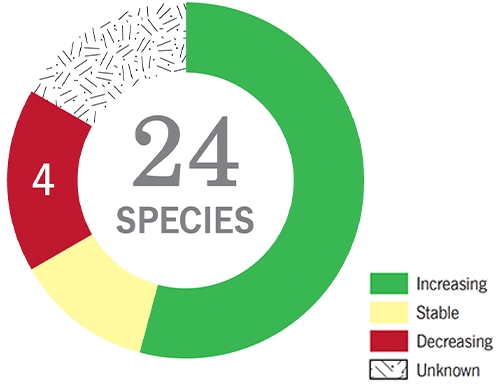This group includes all the hawks, eagles, owls, and falcons. Most of them occupy top positions in their food chains, which historically has been associated with greater risk from chemical contamination, human activity or environmental change.

Northern Harrier
Northern Goshawk
Bald Eagle
Golden Eagle
American Kestrel
Peregrine Falcon
Osprey
Cooper’s Hawk
Broad-winged Hawk
Red-tailed Hawk
Owls
Merlin
Some raptors have been the beneficiaries of focused conservation actions. The banning of DDT in the 1970s, combined with targeted efforts such as captive breeding, allowed for recovery of Osprey, Bald Eagle, and Peregrine Falcon across the eastern United States. Smaller raptors such as the Cooper’s Hawk have likely increased at least in part thanks to efforts initiated for other species. As a result, most of the birds in this group are increasing or stable. Our only declining breeder is the American Kestrel, although note that the Golden Eagle was extirpated from the state back in the 1950s.
Although many species are doing well, disturbance and pollutants remain problems. Eagles and other birds of prey are still susceptible to lead poisoning, often from carcasses. New chemicals with unknown affects are continually released into the environment. American Kestrel declines could potentially be tied to pesticides or changes in habitat both on the breeding and wintering grounds.
Forest-dwelling raptors (e.g. Northern Goshawk) often require relatively large tracks of unbroken habitat, and benefit from land protection efforts. Although there is concern about various emerging environmental contaminants, more research is needed to understand the prevalence and effects of these chemicals on birds of prey. Efforts to help kestrels by erecting nesting boxes are expanding in New England.
Although most species in this group are well-monitored, the nocturnal owls are not usually detected by traditional survey methods, and we lack robust data on their population trends.
Information for the species profiles on this website was compiled from a combination of the sources listed below.
The Birds of New Hampshire. By Allan R. Keith and Robert B. Fox. 2013. Memoirs of the Nuttall Ornithological club No. 19.
Atlas of the Breeding Birds of New Hampshire. Carol R. Foss, ed. 1994. Arcadia Publishing Company and Audubon Society of New Hampshire
Birds of the World. Various authors and dates. Cornell Laboratory of Ornithology.
Data from the Breeding Bird Survey
Data from the Christmas Bird Count